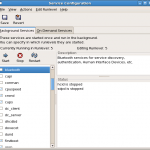A network or network infrastructure is the grouping of hardware devices and software components needed to connect devices within an organization and to connect the organization to other organizations and the Internet. The network infrastructure’s physical hardware and logical components are needed to provide a number of features for the network, including connectivity, routing and switching capabilities, network security, and access control. The network or network infrastructure has to exist before a number of servers needed to support applications that users need can be deployed into a networking environment. Therefore, Read More
Understanding Fault Tolerance
An Introduction to Fault Tolerance The following issues initiate downtime: Hardware Failures: Hardware failures can be described as failures that occur in mechanisms like disks or storage media. Hardware failures tend to offset other failures. It is recommended to utilize platforms that can monitor internal temperatures, as well as trigger alarms accordingly. With random access memories, error correcting codes (ECCs) can be utilized to identify and correct single errors and to identify two-bit errors. Software Failures: Determining the reason of a system outage can be quite intricate. Virus protection defects Read More
Implementing Windows Cluster Service
Planning for a Cluster Service Implementation A number of factors have to be determined when you plan for your Cluster Service implementation. A few items which you should include in your planning phase are listed here: Determine which applications and network services are the mission-critical applications of the organization that need high availability. Determine which clustering technology to implement that would ensure high levels of availability for the mission-critical applications previously identified. Here, you should identify those applications which should be used with Cluster Service, and those applications which should Read More
The Shutdown Event Tracker
An Overview on Shutdown Events Computer shutdowns can be sorted into either of the following categories: Expected shutdowns: An expected shutdown can be defined as a computer shutdown which you predict to occur. Expected shutdowns usually occur when one of the following actions are performed: Clicking Start, and then the Shutdown command Holding down Ctrl + Alt + Del, and then clicking Shutdown Expected shutdown can be categorized into: Planned shutdowns: These are shutdowns which administrators have some form of control over Unplanned shutdowns: These are shutdowns normally initiated by Read More
Macintosh and Windows Server Integration
Macintosh Services Overview While in the earlier days, it was somewhat difficult to integrate Macintosh networks and Windows networks because each operating system basically used different protocols, and files structures and systems. To deal with these integration issues, Microsoft has since introduced the File Server for Macintosh (FSM) and Print Server for Macintosh (PSM) services with Windows NT Server. These FSM and PSM Macintosh services are also included with Windows 2000 and Windows Server 2003. When the FSM and PSM Macintosh services are installed, it enables Macintosh clients to access Read More
Understanding ASR
Automated System Recovery (ASR) Overview Previously, in the Windows NT and Microsoft Windows 2000 operating systems, the emergency repair disk (ERD) feature was used to recover the system when disasters occurred. Windows XP Professional and Windows Server 2003 now include the Automated System Recovery (ASR) feature for recovering the system in disaster situations. The Automated System Recovery (ASR) feature is a new feature found in the Windows Backup utility. ASR should be used to restore the system when all other disaster recovery tools are unavailable or do not work. ASR Read More
Novell Netware and Windows Server
Interoperating with Novell NetWare Windows Server 2003 includes a few specific services that enable Novell NetWare servers and clients, and Windows computer to interoperate: NWLink IPX/SPX/NetBIOS Compatible Transport Protocol (NWLink): NWLink IPX/SPX is the Microsoft implementation of Novell's NetWare Internetwork Packet Exchange/Sequenced Packet Exchange (IPX/SPX) protocol. NWLink IPX/SPX is simply called NWLink. NWLink is used in Novell NetWare, and can be considered IPX for Windows. NWLink is an IPX/SPX compatible transport protocol that was developed to enable Windows 2000 computers to communicate with NetWare services. It is therefore used when Read More
Optimizing Servers for Application Performance
Monitoring Server Performance and Activity One of the basic steps to optimizing server performance is to monitor server performance. To optimize server performance, you can perform a number of tasks, such as: Reducing the load of network traffic on the particular server by implementing load balancing strategies. Reducing CPU usage Improving disk I/O In order to optimize server performance for whatsoever reason, you need to start by monitoring the server. In most cases, before server monitoring commences, it is common practice to establish baseline performance metrics for the specific server. Read More
Using the Terminal Services Configuration Tool

In order for clients to establish Terminal Services sessions on a server, listener connections have to be configured on the particular server. A listener connection can be configured for only RDP (Remote Data Protocol) over TCP/IP. One listener connection can be configured for a network interface card (NIC) in the Terminal Services computer. The Terminal Services Configuration tool creates new listener connections to change configuration settings on existing listener connections and to configure server policy settings. While it is recommended to configure Terminal Services connections through Group Policy, the Terminal Read More
Deploying Service Packs and Hotfixes
What are Service Packs and Hotfixes Service packs and hotfixes are network updates that need to be applied to network computers. Hotfixes are also sometimes referred to as security hotfixes or security fixes. Before delving into the differences between service packs, and hotfixes; you can think of a service pack as being a collection of updates, or large executable files that relate to an Operating System (OS), and a hotfix as being one or multiple files that are applied to the OS to fix a specific critical problem. Service packs Read More


Share on: